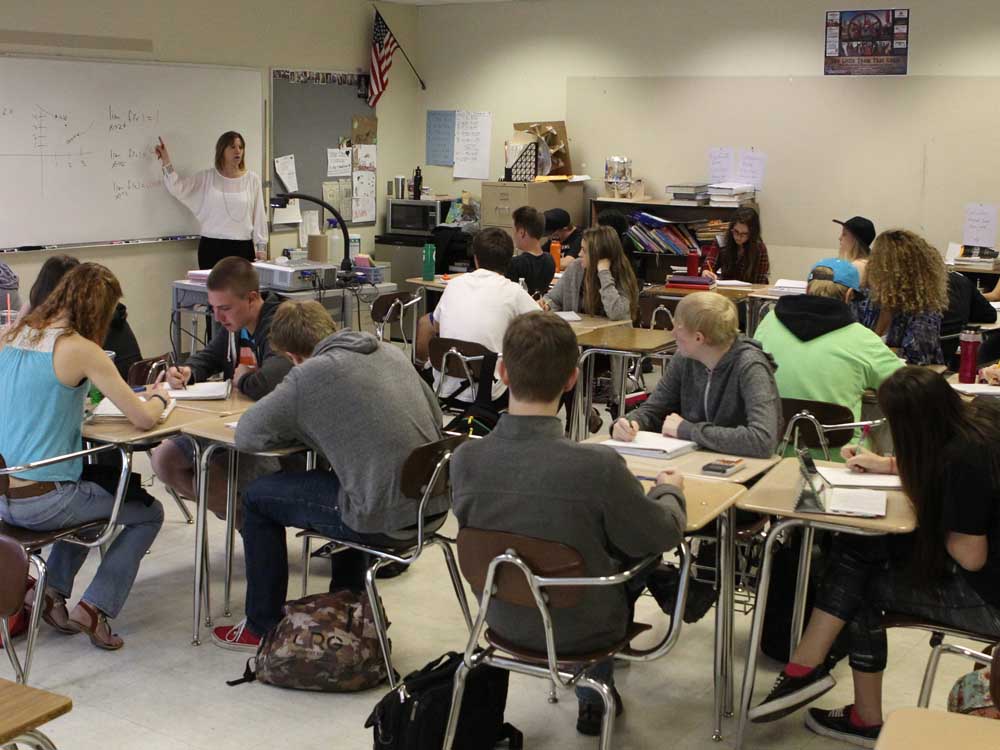Expanding access to college credits
Published 12:00 am Tuesday, April 21, 2015

- A class at Mountain View High School. (Andy Tullis / Bulletin file photo)
If they’re doing the work, why not get the credit?
That’s the argument behind the push to offer college credit to more Central Oregon high schoolers.
Last April, Cascades Commitment, an initiative that brought together Central Oregon Community College and 11 high schools to offer dual-credit courses, was awarded $450,000 by the Oregon Education Investment Board. Organizers say beginning this fall, students may be able to earn college credit in writing and math at every public high school in the tri-county area.
Schools have long offered dual-credit classes in conjunction with COCC — earning students high school and college credit at the same time — but one challenge has been instructor qualifications. Community college instructors must have a master’s degree or a certain number of graduate-level credits in that field, but most high school teachers have master’s degrees in education. While some schools had teachers that met the requirement, others didn’t, meaning students had uneven access to college credit.
“We wanted to make sure no matter which high school you went to in Central Oregon, you’d have access to these college credits,” said Paul Andrews, deputy superintendent at High Desert Education Service District, which administered the grant.
Cascades Commitment was modeled after Eastern Promise, a partnership in Eastern Oregon among community colleges, school districts and Eastern Oregon University, where high school teachers teach classes and college faculty do the grading. In Central Oregon, the goal was to qualify more teachers to teach college classes.
Last summer, high school writing teachers took a weeklong training and were then qualified to teach the equivalent of COCC’s Writing 121 and 122 at their high school in the fall; math teachers took a half-day training and could then teach the equivalent of Math 111.
Teachers meet regularly with COCC faculty to go over course material and ensure they are grading to the college’s standards. About 30 teachers participated in the process, and more trainings will be offered in June. Teachers also earn credit through OSU-Cascades, which may offer dual-credit classes once it expands into a four-year campus.
Since last summer, seven high school teachers have been approved to teach dual-credit classes, according to Debbie Hagan, COCC’s director of secondary programs. While not a big change, making it easier for teachers to get approved means schools won’t depend on one teacher to offer dual-credit classes.
“We may for years be able to (offer) Writing 121, for example, but if that teacher retires or moves to another school, then that school doesn’t offer Writing 121. It’s to backfill and make sure schools don’t rely on one teacher,” she said.
The trainings started with writing and math since almost every college degree requires writing and math credits, Andrews said. But schools offer various dual-credit courses depending on who can teach what, from the plants of the Pacific Northwest course at Crook County High to welding at Redmond High. Students pay $15 per credit, a discount compared to COCC’s in-district tuition of $87 per credit this year.
Hagan said the advanced coursework introduces students to the rigors and expectations of college: “This is a start to their COCC transcript. We hammer that in pretty hard — you need to pay attention.”
High schoolers can also earn college credit through Advanced Placement or International Baccalaureate classes. Some districts, including Redmond, Crook County and Jefferson County, offer so-called fifth-year programs, where students can attend community college free for a year after completing their high school graduation requirements.
The thinking in each case is to get students started on the college path while they are still in high school, or even younger. Some of the $450,000 grant went to train teachers in the AVID model — for Advancement Via Individual Determination — that promotes higher education and Paso y Paso, a college prep program for Latino students at area middle schools.
Last week, officials from Oregon Education Investment Board visited Mountain View High School in Bend, which offers the most dual-credit courses in the area, and COCC to talk with teachers and faculty about the partnership. The grant runs out at the end of June, and while the group hopes to train more teachers to teach dual-credit classes, the funding is uncertain.
“We haven’t heard from the state that the funds will be available,” Andrews said.
— Reporter: 541-617-7837,
aspegman@bendbulletin.com






